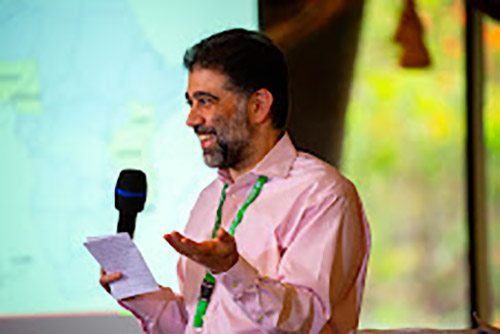With over 200 million cases every year and nearly 700,000 deaths, Malaria is currently one of Africa’s most dreaded sicknesses. While there have been efforts at finding different drugs for treatment, scientists are working on an innovative solution using genetically modified mosquitoes to eradicate malaria spreading mosquitoes in Africa. In this interview with Dr. Michael Santos of GeneConvene Global Collaborative, SEUN AKIOYE finds out how it will work.
Many people in Africa has not heard about the innovative gene drive mosquito eradication. Can you explain what this is about and how it works?
As you know very well, malaria is a tremendous challenge in the world. Over 200 million cases in a year, over 600,000 deaths. Of course, there are existing tools to help prevent and help treat malaria. There was good progress, especially from 2000 to 2015, but from about 2015 to now there has not been much progress in terms of reducing malaria deaths in the world. And many different organizations, you know feel that one of the things that could really help get malaria back on a downward trajectory is innovation; new ways to prevent and treat malaria.
So many different researchers are working on different ways to do that and some of the exciting ways that people are looking at doing that are through genetically engineering mosquitoes in a way that if they get introduced with the wild population of mosquitoes they will spread a genetic change into that population that will prevent the transmission of malaria. Either by making it so that the parasite that causes malaria can’t pass through the mosquito or making it so that there are fewer mosquitoes that transmit malaria.
So this is a very old idea. This idea has been around for 80 years. But recently with the genetic engineering tools like CRISPR, people have been able to engineer these changes into mosquitoes and in laboratories. If they introduce a few of these genetically engineered mosquitoes into a cage with lots of wild mosquitoes, over generations the change will spread through until it gets to all of the population of mosquitoes and either cause that population to decrease or change the mosquitoes in a way that the parasite can’t pass through them.
The question people are asking is that we have vaccines for many diseases, so why not find a vaccine for malaria?
It’s great that there are now two malaria vaccines the RTSS and the r21 vaccine and that’s a tremendous accomplishment scientifically, you know those vaccines require many injections and provide some protection, but that wanes over time. It can still be very important, especially, you know to protect little children and so it’s an important step forward on malaria, but people don’t believe that that those vaccines by themselves would be enough to help eliminate malaria, but they could help scientists continue to work on new vaccines beyond those two and hopefully there will be new and better vaccines as well.
This is such a big and important problem that I think people hope that they need to try many different things because probably no one thing by itself would be enough and hopefully a combination will eventually be enough to eliminate malaria in the world at one time.
So are you saying that we could have the vaccine as well as the genetically engineered mosquitos?
Oh, absolutely. They can work together right because the genetic modifications work on the mosquitoes that transmit malaria, the vaccines work on people to protect them from getting malaria.
Also, of course diagnosing and treatment help get rid of parasites out of people all of these interventions can work together to try to break the chain of transmission and eventually clear malaria and eliminate and eradicate it.
Gates Foundation commits $40m for vaccine production in Africa
Is this safe for the people of Africa and is this what we should be doing? How can you allay the fears of people especially in sub-saharan Africa, who are already suspicious of any genetically modified organisms?
Well all good questions that people everywhere should ask about any technology, right? You know a big part of the work today was funded actually by Grand Challenges almost 20 years ago when Grand Challenges started. One of the areas was to prevent the spread of vector-borne diseases. So this work that’s being done in malaria is being done by academic researchers at different universities and in different institutes across different countries in sub-Saharan Africa.
I think it helps when people hear somebody like Jonathan Kayendo who leads the work in Uganda or people like Brian Tarimo who leads the research that’s happening in Tanzania. You know when they hear these scientists in these countries talk about why they’re doing what they’re doing, I hope people believe that the motive is to address the huge problem of malaria. This is all academic work, all nonprofit work.
There’s no for-profit companies involved in this and in terms of the risks, for anything new people should care about evaluating the risks of it. One of the things that my organization does is actually fund work on risk assessment where there were consultative workshops. One was held in each of the four regions of Africa by the African Union Development Agency to bring together stakeholders to identify areas of concern and then there’s a lot of work done to list out all of the risks, to look at the pathways to harm and determine what the likelihood of different risks are and then to make that available. So these reports get published publicly. So it’s very important in my opinion, to be transparent about that.
And the goal of my organization is to help people make informed decisions. So my group doesn’t develop any of these technologies and we don’t advocate for any of these technologies, we just try to help provide information so that other people can decide how they want to move forward?
So far the assessment of risks has not identified anything that seems like a large risk, one genetically modified mosquitoes have been studied in other places. There’s a trial in Florida in the United States right now and in Brazil, there have been many trials and they’re actually commercially available if you live in Brazil, you can go online and order a box of mosquito eggs that shows up at your home. You add water and genetically modified mosquitoes fly out.
So you can buy this right now in Brazil, there is some work going on in Colombia. Like I said, there’s work in the United States there’s also different approaches where instead of genetically modifying mosquitoes, they infect them with a bacterium and these are the mosquitoes in the United States. These are the mosquitoes that transmit dengue and yellow fever. And those same kind of mosquitoes they can infect with this bacteria and it stops them from transmitting dengue.
And so that’s been studied in Australia. It’s been studied in Indonesia. It’s been studied in Vietnam, in Brazil and Colombia so gene drive has never been studied before but these other kinds of approaches of modifying mosquitoes and then releasing them into the environment and having them work in the environment have been studied so there are some precedents, there has been one release of genetically modified mosquitoes in Africa already.
One of the problems that may show up with this model is the size of the country like Nigeria, how do you hope to cover the entire country if this is approved?
Well one of the exciting things about these gene drive approaches that people have engineered is that once you release some of the engineered mosquitoes they spread the change to other mosquitoes they mate with and the mosquitoes fly around a little bit so, you know mosquito here flies over there and mates and then lays eggs here and then those become adults and they fly around and so over time it spreads from where it gets released.
So you don’t need to release it everywhere in order to get it everywhere, you can release in different places and then over time it will spread away from the places that it’s released and populate the entire place.
It would eventually spread across the whole country if you waited long enough so it’s a trade-off between how many times you would want to release and how much you’d want to wait but one of the things that makes it very exciting is that producing a small number of mosquitoes is not very expensive. And so producing and releasing small numbers of mosquitoes in different places is not expected to cost very much.
I was going to ask what is the cost implication of this because if you come to Nigeria the first thing the government will be asking you is what is the cost?
Yes, so I think that that’s one of the most exciting things about it. It’s an intervention where you can probably release a small number of mosquitoes and people raise mosquitoes all the time, researchers do this all the time and just really small numbers of mosquitoes in a location and the mosquitoes will mate and they’ll pass it on and eventually all the mosquitoes in the location will have the genetic change and as the mosquitoes fly the change will spread.
Over time it just goes on its own, you still probably need to spend some money capture the mosquitoes and test them and do some monitoring of how things are going, but how much of that you do is up to how much the country wants to do.
I think the most exciting thing about this is that the cost could be very low and it sustains itself, this gene driver approach. So once it enters it stays.
Another thing that’s exciting is that the people don’t need to do anything like change their behavior. No one needs to go to a clinic. Another part of that is that when they’re in a community everybody in that community benefits, no one is excluded from the benefit regardless of their social standing or economic situation or anything else and so I think it is very exciting to imagine for a community they don’t need to do anything and malaria just goes away, right?
This sounds interesting giving Malaria is a huge problem in Nigeria and many people will do anything to have a permanent solution but if this is accepted how soon do you think this can be deployed? How far gone is the work on research?
That is a question on everyone’s mind. Scientifically, I think the work is very advanced so within a couple of years the researchers that are working on this in different countries will be putting in applications to regulatory authorities because these involve genetic modification you know, every country has a regulator that is responsible and Nigeria has an excellent biosafety law and biosafety regulator.
Those applications will go in and then the countries will decide whether to say yes or not and so if they say yes, I think that within a few years. But I think if things work well, in three or four years people will be begin to know how things are working and then it’s up to governments and communities to decide if this is something they’re excited about and they want to move forward.
It spreads on its own, but it will spread slowly on its own so, if governments and people want it, then you’ll want to release more.
So tell me about your own organization. Tell me what you do and what’s the link with this?
I work at a non-profit foundation called the Foundation for the National Institutes of Health that’s based in the United States and I lead a program called the Gene Convene Global Collaborative and Gene Convene supports informed decision-making about genetic approaches to control mosquitoes to prevent diseases.
Because this is new in many ways we know there are lots of questions so we work with different stakeholders to help identify key questions and help bring people together to answer them, bring insights from other fields. We worked with the World Health Organization to develop a guidance framework for testing genetically modified mosquitoes that the second edition was just published last year and so we work with people and we provide technical advice so people come to us and we have expertise.
One of the things we do is fund risk assessment. We fund work to look at the different risks we also do capacity strengthening. So we run many different trainings, we just had a workshop at the Pan-African Mosquito Control Association Conference that was in Addis Ababa, which is a big malaria control conference that was for people from national malaria control programs to come to learn more about modeling because computer modeling plays a role in trying to figure out how all these work.
So one of the trainings that we provided was to help people understand those models, gain because we’re not making the models. We’re trying to help people say when you see a model what the questions are you should ask, what should you be skeptical about, how should you evaluate it? We also provide like trainings in genetics to researchers mostly to people who are post doctorate or faculty to try to help them be able to go back to their institutions and teach more people.
We want to make sure the resources are there for them to learn more because our entire reason to exist is to help people be better informed about this and so we try to do that every way that we can and one of these ways is to talk with people who want to help share information about this.
- 22 soldiers dead as troops kill 3 terrorist commanders, 67 others in Borno - January 26, 2025
- 79 criminal suspects killed, 224 others arrested in one week – Military - January 24, 2025
- Ukraine attacks Russian oil refinery with 100 drones - January 24, 2025










